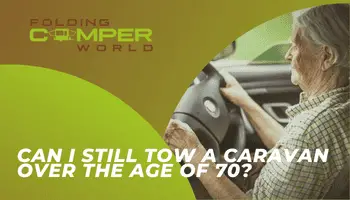Caravanning is a hobby that is enjoyed by a lot of people who consist of different age groups. Whether that may be young couples, families, or the elderly. One question that may come to mind is how long you can continue driving and towing a caravan and if there are any age limits to doing so. It may seem like 70 years is the cut-off point; however, this is not the case, as many elderly drivers can tow their caravan while being much older than 70. However, to do this, several steps need to be taken to remain a legal driver.
To answer the question if you can still tow a caravan over the age of 70, yes, you can. There are no limits to when you have to stop towing a caravan. Rather than basing this decision on age, it is based on your health and ability to drive a car and tow a caravan safely. To assess this, once you are 70 years old, you are asked to renew your licence every three years. Other factors play into this, all of which will be explained in more detail in this blog post.
This blog post will cover the following:
Driving over 70

When you turn 70, your driving licence expires; however, this doesn’t mean that you need to stop driving. If you want to continue driving, you need to renew your licence every three months. There is no requirement for you to take another test to renew your licence, even if you are much older than 70. As long as you are fit enough to drive safely without causing harm to yourself or other drivers on the road, you may continue driving and towing a caravan for as long as you wish.
Renewing your licence is quite a simple process. Around three months prior to your 70th birthday, DVLA sends you a D46P application form that you need to fill in. This can be don’t by post or online; both ways are free. If you think your appearance has changed a lot, then there is also an option here to change your photo at the same time. Once you have done this, the new licence should be sent to you within a week; however, postal applications can take up to three weeks to process.
Driving licence categories

As you should be aware, different categories of driving licences determine which vehicles you can tow and what their weights should be. Most people who have a regular driving licence to drive a car have the B category licence or the BE category licence. The difference between these two is that with a category B licence, you can tow heavier trailers if the total MAM (maximum authorised mass) of the vehicle and trailer is not more than 3,500kg. Whereas with a category BE licence, the size of the trailer depends on when you got your driving licence. If your licence was issued before 19 January 2013, you can tow any size trailer within the towing limits of your vehicle, but if it was issued on or after 19 January 2013, you can tow a trailer with a MAM of up to 3,500kg within the towing limits of your vehicle.
The table below displays the information for each driving licence category for cars, medium vehicles and large vehicles to see what each one entails. Please note that this information has been taken from Gov.UK and is accurate at the time of writing.
| Category | Rules |
|---|---|
| B1 | You can drive motor vehicles with four wheels up to 400kg unladen or 550kg if designed to carry goods. |
| B (passed before 1 January 1997) | You’re usually allowed to drive a vehicle and trailer combination up to 8,250kg MAM. View your driving licence information to check. You’re also allowed to drive a minibus with a trailer over 750kg MAM. |
| B (passed on or after 1 January 1997) | You can drive vehicles up to 3,500kg MAM with up to 8 passenger seats (with a trailer up to 750kg). You can also tow heavier trailers if the total MAM of the vehicle and trailer is not more than 3,500kg. |
| B auto | You can drive a category B vehicle – but only an automatic one. |
| BE | You can drive a vehicle with a MAM of 3,500kg with a trailer. The size of the trailer depends on the BE’ valid from’ date shown on your licence. If the date is: – before 19 January 2013, you can tow any size trailer within the towing limits of the vehicle – on or after 19 January 2013, you can tow a trailer with a MAM of up to 3,500kg within the towing limits of the vehicle |
| C1 | You can drive vehicles between 3,500 and 7,500kg MAM (with a trailer up to 750kg). |
| C1E | You can drive C1 category vehicles with a trailer over 750kg. The combined MAM of both cannot exceed 12,000kg. |
| C | You can drive vehicles over 3,500kg (with a trailer up to 750kg MAM). |
| CE | You can drive category C vehicles with a trailer over 750kg. |
When you reach 70, you can still drive any car (a vehicle up to 3500kg) and tow anything it can legally tow. Keeping within the car’s GTW (gross train weight) is important. This rule is applied to everyone, not just those over 70. This means that when your car and caravan weight are combined, you can have a total weight of up to 7000kg. After three years, if you still meet the health requirements, you can renew your licence and continue driving and towing.
In the rare case that you have a caravan that exceeds this weight, or if you want to drive a motorhome that weighs more than this, then the category B or BE won’t allow you to do this. I used the Practical Caravan online forum and asked caravan users over the age of 70 what to do if they want to tow something heavier than what is allowed on their licence category. The responses I got on this explained that they cannot tow heavier vehicles with a category B or BE licence; however, if they meet the health requirements and the eyesight requirement, then they can apply for a category C1 or C1E licence, which allows them to drive and tow more weight. Please refer to the table above for more information on these licence categories.
One of the forum users to reply to my post was ‘JTQ’, who explained that:
“Before your 70th birthday, you will get the letter with a questionnaire you return making a declaration to the answers you provide; a health issue list but only things even under 70s legally have to notify about. This is the “car” licence route, and the licence will be B+E, the now-standard allowing towing, together with motorcycle rights if you held them.
If you want to drive a vehicle, itself over 3500 kgs, you have to get additional documents that need a doctor to sign, after he satisfies themself of your health issues. The specifics of this for over 3500 kg are not things I know about, other than at any time once over 70 you can apply to “upgrade” from a “car” licence for a plus 3500kg licence.”
Possible medical examinations

As explained above, you may be asked to do some medical examinations when you reach 70 years old to see if you meet the health requirements to continue driving.
If you have a health condition or disability that could affect your driving that DVLA doesn’t know about, you must notify them. You should also provide details if your condition has worsened since your licence was last issued. In this case, you may be required to undergo a medical examination before the DVLA can decide whether or not to issue your new licence. It’s also a good idea to have a check-up between each renewal to make sure you’re still fit enough to drive on the road safely.
Many older people think they will have to stop driving if they declare any medical conditions; however, this is rarely the case. In this event, you may have to make alterations to your car, or you may be issued a shorter-term licence so you can be reviewed a little sooner. It is crucial that you do let the DVLA know about any medical conditions you have, as you could be fined up to £1,000 if you do not. Here are some of the medical conditions that need declaring:
- Dementia
- Diabetes
- Parkinson’s disease
- Epilepsy
- Sleep apnoea
- Any physical disabilities or visual impairments
You’ll also be asked if you meet the minimum eyesight standard for driving on the form you fill in to renew your licence. This is because it’s illegal to drive if you can’t read a standard number plate from a distance of 20 metres. You also need to have a good field of vision, and visual acuity must be at least decimal 0.5 on the Snellen scale.
Retaking your driving test

You may be required to retake your driving test to assess your driving ability if you have a medical condition or a disability. This can be done through your local driver assessment scheme or a mobility centre. This test requires you to drive in your car for about an hour while accompanied by an assessor. You will then be given a report advising you on how you can improve your driving.
If you have a medical condition or disability, a mobility centre can take you through your options. The most common option is to have some adaptations made to your car to help you drive. The assessment at the mobility centre will cover physical and cognitive skills as well as driving in a dual-controlled vehicle.


